In 1992, Loudon Wainwright wrote a song in honor of Bob Dylan’s 50th birthday. “Talking New Bob Dylan” used the great man’s talking blues form to capture a particular era in the music industry. It was the early 1970s.
“Yeah I got a deal and so did John Prine – Steve Forbert and Springsteen, all in a line – They were lookin’ for you, signing up others – We were new Bob Dylans, your dumb ass kid brothers.”
The late 1960s into the early 1970s were the era of the singer-songwriter. Joni Mitchell and Neil Young, Nick Drake and Graham Parsons, John Hartford and Dolly Parton all signed their first major label solo deals right around that time.
These singer-songwriter classics defined the 1970s
I could have chosen songs from any of them, and more, to capture what the early part of the decade sounded like in the voices of a bevy of talented songwriters and their guitars. But I went with these.
“American Pie” by Don McLean (1971)
I was tempted to choose Neil Young’s brilliant “After the Gold Rush” as part of my 1970s roster. Young certainly was closer to Dylan than Don McLean, and his song represented a potent environmental movement that was showing up in pop music.
But “After the Gold Rush” wasn’t a sensation, and “American Pie” was. A bold and sprawling slice of history and nostalgia that helped invent a type of reverence for the early days of rock and roll that has really never departed. McLean has remained cagey about the meaning behind some of his lyrics. But we all knew that the “Satan laughing with delight” was Jagger.
“Me and Bobby McGree” by Janis Joplin (1971)
Maybe this is an odd choice for a singer-songwriter section, seeing as how the songwriter didn’t actually sing this version. But I somehow think this might be the ultimate singer-songwriter number. Kris could sing – not all that well – and Janis could write – somewhat better than Kris could sing.
This version offered the best of both worlds. One of the truly great songwriters of the era is being interpreted by one of the best singers in the history of rock and roll.
Joplin recorded it, unbeknownst to her friend and occasional lover Kristofferson, just days before she died in late 1970. It was released after she died and became an instant sensation, both because of its stunning emotional power and because it signaled the end of such promise and talent.
“American Tune” by Paul Simon (1973)
Simon and Garfunkel had gone out on top. One of their final recordings as a duo – “Bridge Over Troubled Waters” – was the biggest song of 1970. Then Paul began putting out his own solo albums, eventually scoring big with critics and fans alike in 1975 with Still Crazy After All These Years.
Though he had a string of fine singles in the first half of the decade, I don’t think he was ever better than on this poignant lament from There Goes Rhymin’ Simon in 1973. Accompanied mostly by his acoustic guitar, strings enter on the bridge to help the song soar.
Simon captured a particular moment when the promise of the ‘60s was fading into distant memory and a country was facing “the age’s most uncertain hour.”
“At Seventeen” by Janis Ian (1975)
Helen Reddy’s “I Am Woman” may have been the ubiquitous spark of early feminism, but I responded to Ian’s more introspective tune at the time and still do to this day. It is one of the most evocative pieces of poetry of the decade.
Ian’s barely whispered vocals, which were even more exaggerated during her performance on the very first Saturday Night Live episode (when she reports she was very sick with strep throat), made it iconic.
“The Wreck of the Edmund Fitzgerald” by Gordon Lightfoot (1976)
Here’s the thing. Bob Dylan is not on this list. That’s not because he didn’t put out some spectacular music in the ‘70s. In 1976, his album Desire stands toe-to-toe with his best work from the 1960s. A year earlier, Blood on the Tracks was even better – on the short list of greatest albums of the modern era. “Tangled Up in Blue” doesn’t take a back seat to any singer-songwriter number.
However, though they were filled with marvelous songs, none were ubiquitous. “The Wreck of the Edmund Fitzgerald” was. The haunting tale of a shipwreck by one of the few songwriters Dylan truly admired had the feel of an old ghost story, but it was a recent tragedy that Lightfoot turned into six and a half minutes of compelling drama.
It doesn’t even have a chorus – just mounting dread. It still carries that weight today, playing as a chilling accent in season 2 of Severance.
